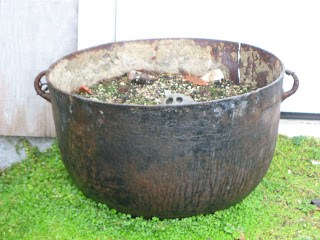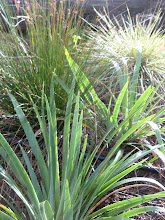
I've been reading a book called The Four Ages of Tsurai, which is a compilation of the European accounts (including one by botanist Archibald Menzies) of the small Yurok village of Tsurai, which was just below the modern town of Trinidad, where I go for internet and library books.
"Olega’ “where they come.” A place near the end of the present wharf which got its name because objects continually drift ashore there."

Trinidad Head is a great place to see plant diversity.
Ribes sanguineum.

The flowers, as you can see, are very beautiful. They're one of the most popular CA natives in cultivation.
 I don't know what this litte plant is. Shame.
I don't know what this litte plant is. Shame.
it would turn out well."



Salal (Gaultheria shallon) is a common plant along the coast. The berries are good in muffins, and have an interesting crunch to them.


Trinidad Head may be the best place to find Mimulus aurantiacus in this area. I saw it in gardens before I noticed it in the wild. Here's a tiny plant growing on a rock.

Fringecup (Tellima grandiflora) is a common ground cover in the shade, yet we don't have any in Bayside. (Even stranger is our very sparse amount of Oxalis oreganum, the most common redwood forest plant anywhere else.)


Much of the head is covered in deciduous thickets. Thimbleberry, Twinberry, Blackberry, Gooseberry, and...poison oak.
It seems the Tsurai had a name and story for every rock along the coast. I wonder if today's fishermen have named all the rocks (I bet they have).

Joseph Cambell says, "People claim the land by creating sacred sites, by mythologizing the animals and plants—they invest the land with spiritual powers. It becomes like a temple, place for meditation."
History, hikes, and gardening are great ways to build your temple.
Through intermarriage with whites, disease, and migration to reservations, Tsurai faded away and was completely abandoned by 1914. California has a violent history, especially in respects to the orginal inhabitants. (The Wiyots, the Yuroks southern neighbors who inhabitted Bayside, were massacred nearly to extinction.) But the town of Tsurai faded quietly away.
I haven't confirmed this, but according to the book, the site of Tsurai is grown over, but is marked by a great pepperwood tree (Umbellularia californica).
"If aromatic angelica root was burned beneath its branches and a person prayed for rain, the rain would come in two days...Children were warned to stay away from this tree lest bad luck befall them. If an infant died, the mother...hung the cradle in its branches."The world is composed of sacred sites.











 See, it's a highway, forgotten.
See, it's a highway, forgotten.























